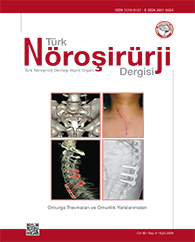Türk Nöroşirürji Dergisi
2020 , Vol 30 , Num 3
Posttraumatic Syringomyelia
1Necmettin Erbakan Üniversitesi Meram Tıp Fakültesi, Beyin ve Sinir Cerrahisi Anabilim Dalı, Konya, Türkiye
Syringomyelia is a progressive, rare disease characterized by cystic cavitation in the spinal cord. Trauma is an important etiological
cause of syrinx development. Posttraumatic syringomyelia may result from a variety of inherent conditions and traumatic events, or
from some combination of these. Many hypotheses have arisen to explain this complex disorder, but no consensus has emerged.
Posttraumatic syringomyelia is becoming increasingly recognized as a sequel to major and minor spinal cord injury, paralleling
the development and widespread availability of magnetic resonance imaging as a diagnostic modality for evaluating possible
spinal pathologic lesions. The incidence of posttraumatic syringomyelia was 3% of all medulla spinalis injuries before magnetic
resonance imaging entering clinical use, but is now 12% after MRI usage. The most important cause of late, subacute or progressive
neurological worsening in spinal cord injuries is traumatic syringomyelia. Surgical treatment criteria should be selected according to
the lesion. Surgical intervention is recommended in the setting of motor and/or sensory neurologic deterioration as a consequence
of post-traumatic syrinx. In traumatic syringomyelia, the preoperative neurological findings and MRI findings of the patient should
be evaluated together and appropriate surgical intervention should be selected according to the outcome.
Anahtar Kelimeler :
Surgery, Syringomyelia, Spinal injury, Posttraumatic

